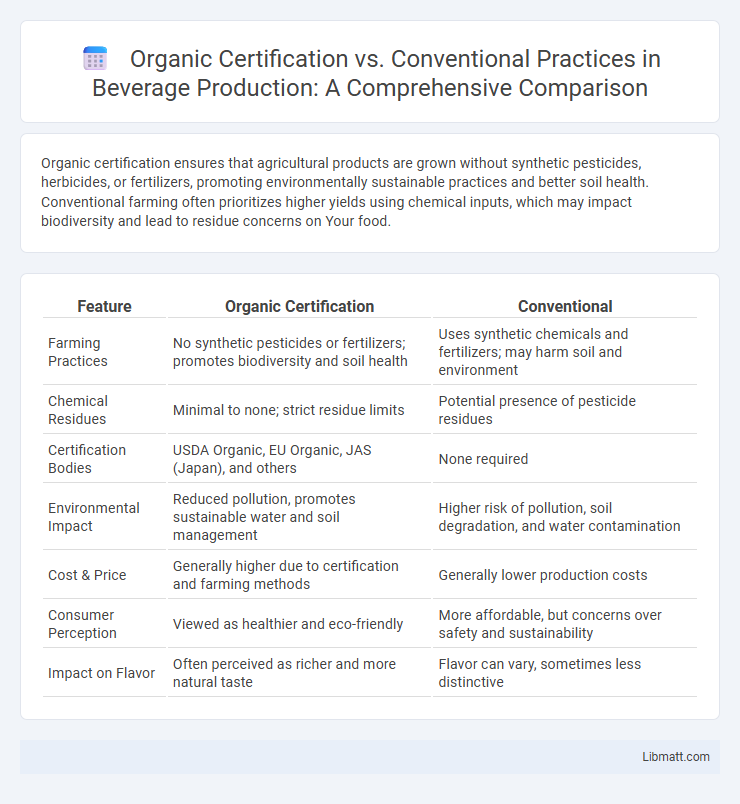Organic certification ensures that agricultural products are grown without synthetic pesticides, herbicides, or fertilizers, promoting environmentally sustainable practices and better soil health. Conventional farming often prioritizes higher yields using chemical inputs, which may impact biodiversity and lead to residue concerns on Your food.
Table of Comparison
| Feature | Organic Certification | Conventional |
|---|---|---|
| Farming Practices | No synthetic pesticides or fertilizers; promotes biodiversity and soil health | Uses synthetic chemicals and fertilizers; may harm soil and environment |
| Chemical Residues | Minimal to none; strict residue limits | Potential presence of pesticide residues |
| Certification Bodies | USDA Organic, EU Organic, JAS (Japan), and others | None required |
| Environmental Impact | Reduced pollution, promotes sustainable water and soil management | Higher risk of pollution, soil degradation, and water contamination |
| Cost & Price | Generally higher due to certification and farming methods | Generally lower production costs |
| Consumer Perception | Viewed as healthier and eco-friendly | More affordable, but concerns over safety and sustainability |
| Impact on Flavor | Often perceived as richer and more natural taste | Flavor can vary, sometimes less distinctive |
Understanding Organic Certification Standards
Organic certification standards require strict adherence to natural farming practices, prohibiting synthetic pesticides, genetically modified organisms (GMOs), and chemical fertilizers to ensure environmental sustainability and food safety. Conventional farming allows synthetic inputs and genetically engineered products, prioritizing high yield and cost-effectiveness over ecological balance. Understanding these standards helps you make informed choices about the health and environmental impact of your food.
Key Principles of Conventional Farming
Conventional farming relies on synthetic chemical fertilizers, pesticides, and herbicides to maximize crop yields and control pests. It emphasizes monoculture practices, mechanization, and genetically modified organisms (GMOs) to enhance productivity and efficiency. Soil health is often managed through external inputs rather than natural processes, distinguishing conventional methods from organic certification standards.
Regulatory Differences: Organic vs Conventional
Organic certification mandates strict adherence to standards set by regulatory bodies such as the USDA or EU Organic Regulation, emphasizing prohibitions on synthetic pesticides, GMOs, and chemical fertilizers. Conventional farming operates under less restrictive regulations, allowing the use of synthetic chemicals, pesticides, and fertilizers approved by agencies like the EPA but without the stringent oversight required for organic labeling. Compliance with organic regulations involves rigorous documentation, regular inspections, and traceability, distinguishing it fundamentally from conventional agricultural regulatory frameworks.
Environmental Impact: Organic and Conventional Methods
Organic certification methods prioritize soil health, biodiversity, and reduced chemical runoff, significantly lowering environmental impact compared to conventional farming. Conventional methods often rely on synthetic fertilizers and pesticides, which can contribute to soil degradation, water pollution, and greenhouse gas emissions. Choosing organic practices supports sustainable ecosystems and helps protect your natural resources for future generations.
Use of Pesticides and Fertilizers
Organic certification mandates the exclusive use of natural pesticides and fertilizers, prohibiting synthetic chemicals to promote ecological balance and soil health. Conventional farming frequently employs synthetic pesticides and chemical fertilizers to enhance crop yield and control pests, which may lead to soil degradation and water contamination. The regulated restriction on synthetic inputs in organic farming supports sustainable agriculture and reduces environmental impact.
Impact on Soil Health and Biodiversity
Organic certification promotes soil health through practices like crop rotation, composting, and reduced chemical inputs, which enhance microbial activity and nutrient cycling. Conventional farming often relies on synthetic fertilizers and pesticides, potentially degrading soil structure and reducing biodiversity over time. Studies show organic systems support higher biodiversity levels, contributing to ecosystem resilience and sustainable agricultural productivity.
Nutritional Value Comparison
Organic certification ensures crops are grown without synthetic pesticides or fertilizers, often resulting in produce with higher antioxidant levels and certain vitamins compared to conventional methods. Studies indicate organic fruits and vegetables may contain up to 40% more antioxidants and have lower pesticide residues, promoting better nutritional quality. Your choice between organic and conventional impacts intake of beneficial nutrients and exposure to chemical residues.
Economic Considerations for Farmers
Organic certification often demands higher upfront costs due to certification fees, specialized labor, and organic inputs, while conventional farming typically benefits from established supply chains and subsidies. You may experience fluctuating market premiums for organic products that can offset these expenses, yet the transition period can create economic strain due to lower initial yields. Enhanced consumer demand for organic produce offers growth potential, but farmers must carefully assess market stability and cost-benefit dynamics before committing to certification.
Consumer Perceptions and Market Demand
Consumer perceptions often favor organic certification due to beliefs about health benefits, environmental sustainability, and absence of synthetic pesticides, driving a premium market demand. Conventional products, while generally priced lower, face increasing scrutiny as more consumers prioritize organic labels for food safety and ethical reasons. Your purchasing decisions impact market trends, with organic certification serving as a key indicator of quality and trust among health-conscious buyers.
Challenges and Future Trends in Organic and Conventional Farming
Organic certification presents challenges such as stringent compliance with pesticide restrictions, soil health management, and higher production costs compared to conventional farming, which often relies on synthetic fertilizers and pesticides to maximize yield. Future trends show an increasing integration of technology like precision agriculture and data-driven pest control in both systems to improve sustainability and efficiency. Your decision between organic and conventional farming will depend on balancing regulatory demands, market access, and consumer preference trends toward eco-friendly practices.
Organic certification vs conventional Infographic

 libmatt.com
libmatt.com